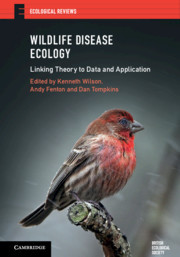Wildlife Disease Ecology Linking Theory to Data and Application Ecological Reviews Series
Langue : Anglais
Coordonnateurs : Wilson Kenneth, Fenton Andy, Tompkins Dan

Introduces readers to key case studies that illustrate how theory and data can be integrated to understand wildlife disease ecology.
Just like humans, animals and plants suffer from infectious diseases, which can critically threaten biodiversity. This book describes key studies that have driven our understanding of the ecology and evolution of wildlife diseases. Each chapter introduces the host and disease, and explains how that system has aided our general understanding of the evolution and spread of wildlife diseases, through the development and testing of important epidemiological and evolutionary theories. Questions addressed include: How do hosts and parasites co-evolve? What determines how fast a disease spreads through a population? How do co-infecting parasites interact? Why do hosts vary in parasite burden? Which factors determine parasite virulence and host resistance? How do parasites influence the spread of invasive species? How do we control infectious diseases in wildlife? This book will provide a valuable introduction to students new to the topic, and novel insights to researchers, professionals and policymakers working in the field.
Preface: wildlife disease ecology; Glossary of terms; Part I. Understanding Within-Host Processes: 1. Pollinator diseases: the Bombus-Crithidia system; 2. Genetic diversity and disease spread: epidemiological models and empirical studies of a snail-trematode system; 3. Wild rodents as a natural model to study within-host parasite interactions; 4. From population to individual host scale and back again: testing theories of infection and defence in the Soay sheep of St Kilda; 5. The causes and consequences of parasite interactions: African buffalo as a case study; 6. Effects of host lifespan on the evolution of age-specific resistance: a case study of anther-smut disease on wild carnations; 7. Sexually transmitted infections in natural populations: what have we learnt from beetles and beyond?; Part II. Understanding Between-Host Processes: 8. Using insect baculoviruses to understand how population structure affects disease spread; 9. Infection and invasion: study cases from aquatic communities; 10. Parasite mediated selection in red grouse – consequences for population dynamics and mate choice; 11. Emergence, transmission and evolution of an uncommon enemy: Tasmanian devil facial tumour disease; 12. Bovine tuberculosis in badgers: sociality, infection and demography in a social mammal; 13. Mycoplasma ovipneumoniae in bighorn sheep: from exploration to action; 14. Manipulating parasites in an Arctic herbivore: gastrointestinal nematodes and the population regulation of Svalbard reindeer; Part III. Understanding Wildlife Disease Ecology at the Community and Landscape Level: 15. The ecological and evolutionary trajectory of oak powdery mildew in Europe; 16. Healthy herds or predator spreaders? Insights from the plankton into how predators suppress and spread disease; 17. Multi-trophic interactions and migration behaviour determine the ecology and evolution of parasite infection in monarch butterflies; 18. When chytrid fungus invades: integrating theory and data to understand disease- induced amphibian declines; 19. Ecology of a marine ectoparasite in farmed and wild salmon; 20. Mycoplasmal conjunctivitis in house finches: the study of an emerging disease; 21. Heterogeneities in infection and transmission in a parasite-rabbit system: key issues for understanding disease dynamics and persistence; 22. Sylvatic plague in Central Asia: a case study of abundance thresholds.
Kenneth Wilson is Professor of Evolutionary Ecology at Lancaster University. With more than twenty-five years' experience in studying wildlife disease ecology, he has published more than 120 peer reviewed articles and chapters, and is Senior Editor of the Journal of Animal Ecology.
Andy Fenton is Professor of Theoretical Ecology at the University of Liverpool. He is on the Editorial Board of the Journal of Animal Ecology and Parasitology and has published more than eighty peer reviewed papers.
Dan Tompkins is Project Manager Science Strategy at Predator Free 2050 Ltd, Auckland, and Honorary Professor in the Department of Zoology, University of Otago, New Zealand.
Andy Fenton is Professor of Theoretical Ecology at the University of Liverpool. He is on the Editorial Board of the Journal of Animal Ecology and Parasitology and has published more than eighty peer reviewed papers.
Dan Tompkins is Project Manager Science Strategy at Predator Free 2050 Ltd, Auckland, and Honorary Professor in the Department of Zoology, University of Otago, New Zealand.
Date de parution : 11-2019
Ouvrage de 690 p.
17.5x24.5 cm
Disponible chez l'éditeur (délai d'approvisionnement : 14 jours).
Prix indicatif 64,99 €
Ajouter au panierDate de parution : 11-2019
Ouvrage de 690 p.
18x25.2 cm
Disponible chez l'éditeur (délai d'approvisionnement : 14 jours).
Prix indicatif 127,71 €
Ajouter au panierThème de Wildlife Disease Ecology :
© 2024 LAVOISIER S.A.S.



